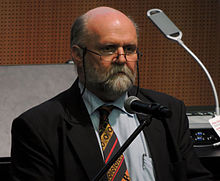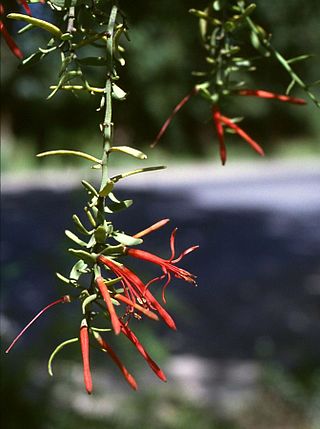
Loranthaceae, commonly known as the showy mistletoes, is a family of flowering plants. It consists of about 75 genera and 1,000 species of woody plants, many of them hemiparasites. The three terrestrial species are Nuytsia floribunda, Atkinsonia ligustrina, and Gaiadendron punctatum Loranthaceae are primarily xylem parasites, but their haustoria may sometimes tap the phloem, while Tristerix aphyllus is almost holoparasitic. For a more complete description of the Australian Loranthaceae, see Flora of Australia online., for the Malesian Loranthaceae see Flora of Malesia.
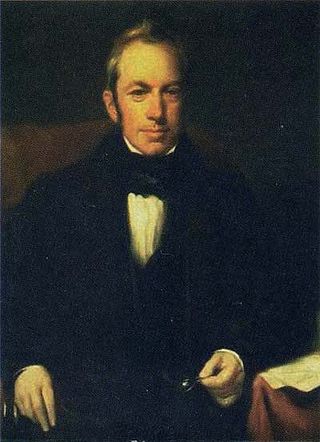
Robert Brown was a Scottish botanist and paleobotanist who made important contributions to botany largely through his pioneering use of the microscope. His contributions include one of the earliest detailed descriptions of the cell nucleus and cytoplasmic streaming; the observation of Brownian motion; early work on plant pollination and fertilisation, including being the first to recognise the fundamental difference between gymnosperms and angiosperms; and some of the earliest studies in palynology. He also made numerous contributions to plant taxonomy, notably erecting a number of plant families that are still accepted today; and numerous Australian plant genera and species, the fruit of his exploration of that continent with Matthew Flinders.
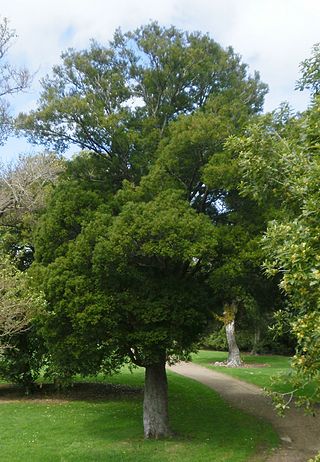
Prumnopitys is a genus of conifers belonging to the family Podocarpaceae. The nine recognized species of Prumnopitys are densely branched, dioecious evergreen trees up to 40 metres in height.

The genus Bowenia includes two living and two fossil species of cycads in the family Stangeriaceae, sometimes placed in their own family Boweniaceae. They are entirely restricted to Australia.

Ralph Tate was a British-born botanist and geologist, who was later active in Australia.

Julian Edmund Tenison-Woods, commonly referred to as Father Woods, was an English Catholic priest and geologist who served in Australia. With Mary MacKillop, he co-founded the Sisters of St Joseph of the Sacred Heart at Penola in 1866.

Alexander Segger George is an Australian botanist. He is an authority on the plant genera Banksia and Dryandra. The "bizarre" Restionaceae genus Alexgeorgea was named in his honour in 1976.

Professor David John Mabberley, is a British-born botanist, educator and writer. Among his varied scientific interests is the taxonomy of tropical plants, especially trees of the families Labiatae, Meliaceae and Rutaceae. He is perhaps best known for his plant dictionary The plant-book. A portable dictionary of the vascular plants. The third edition was published in 2008 as Mabberley's Plant-book, for which he was awarded the Engler Medal in Silver in 2009. As of June 2017 Mabberley's Plant-book is in its fourth edition.
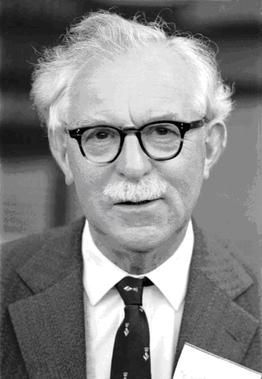
William Thomas Stearn was a British botanist. Born in Cambridge in 1911, he was largely self-educated and developed an early interest in books and natural history. His initial work experience was at a Cambridge bookshop, but he also had a position as an assistant in the university botany department. At the age of 29 he married Eldwyth Ruth Alford, who later became his collaborator, and he died in London in 2001.

Nancy Tyson Burbidge was an Australian systemic botanist, conservationist and herbarium curator.

The Clarke Medal is awarded by the Royal Society of New South Wales, the oldest learned society in Australia and the Southern Hemisphere, for distinguished work in the Natural sciences.
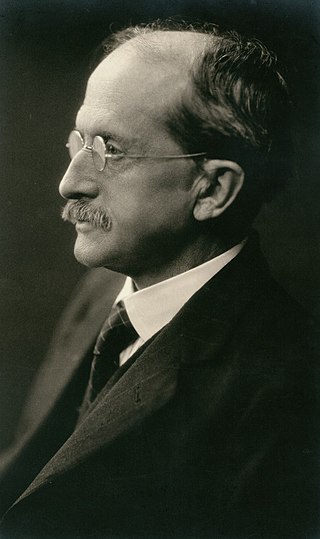
John McConnell Black was a Scottish botanist who emigrated to Australia in 1877 and eventually documented and illustrated thousands of flora in South Australia in the early 20th century. His publications assisted many botanists and scientists in the decades that followed. He was the younger brother of theatre and hotel manager Helen Carte.
Banksieaephyllum is a plant genus that encompasses organically preserved fossil leaves that can be attributed to the Proteaceae tribe Banksieae, but cannot be attributed to a genus.

William Brian Keith Holmes is an Australian palaeobotanist, best known for his work "Fructifications of Glossopteris" (1974), published in the Proceedings of the Linnean Society of New South Wales. Despite having received no formal training in palaeontology, he has become an important contributor in the field and has described some 80 new species, mostly from 2 quarries at Nymboida in northern New South Wales, and situated on the Triassic.
Sir Rutherford Ness "Bob" RobertsonFRSE was an Australian botanist and biologist, and winner of the Clarke Medal in 1955.
Pauline Yvonne Ladiges is a botanist whose contributions have been significant both in building the field of taxonomy, ecology and historical biogeography of Australian plants, particularly Eucalypts and flora, and in science education at all levels. She is professorial fellow in the School of Botany at the University of Melbourne, where she has previously held a personal chair and was head of the School of Botany at the University of Melbourne from 1992 to 2010. She has been a fellow of the Australian Academy of Science since 2002. The standard author abbreviation Ladiges is used to indicate this person as the author when citing a botanical name.
Judith Gay West is an Australian scientist currently working as an executive director of the Australian National Botanic Gardens. West holds a doctor of philosophy (PhD) by thesis on "A taxonomic revision of Dodonaea (Sapindaceae) in Australia". She completed her PhD in 1981 from the University of Adelaide, South Australia.

Melaleuca acuminata, commonly known as mallee honeymyrtle is a plant in the myrtle family, Myrtaceae and is native to Australia and widespread in temperate areas of the continent. It is an erect shrub to about 3 m (9.8 ft) usually found in mallee woodland.

Noel Charles William Beadle was an Australian botanist and plant ecologist who spent most of his working life at the University of New England in Armidale.

Roger Charles Carolin is a botanist, pteridologist and formerly an associate professor at Sydney University. He was appointed as a lecturer in botany at the University of Sydney in 1955 earned a Ph.D from Sydney University in 1962 with a thesis on the floral morphology of the campanales, and retired as an associate professor in 1989.
